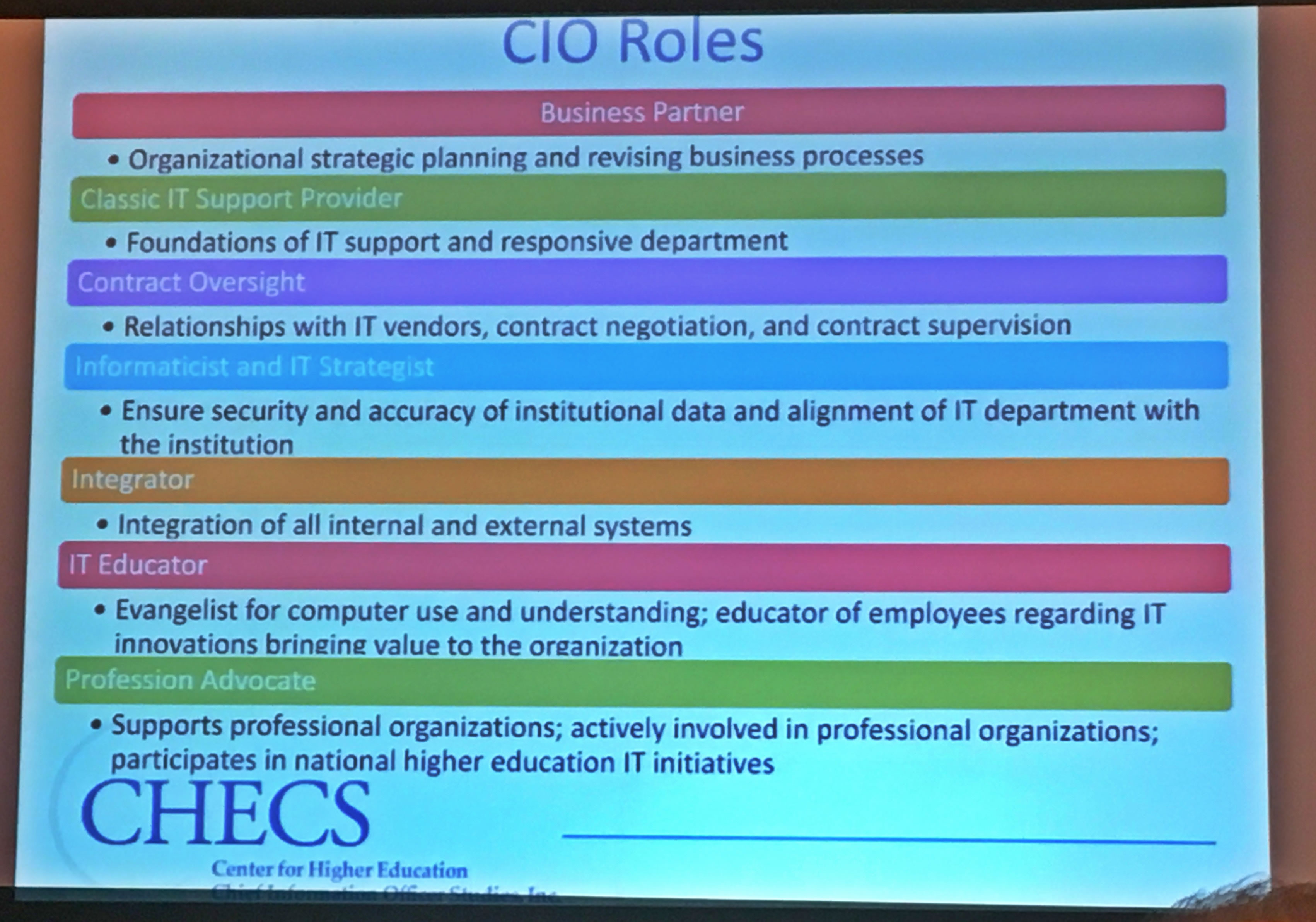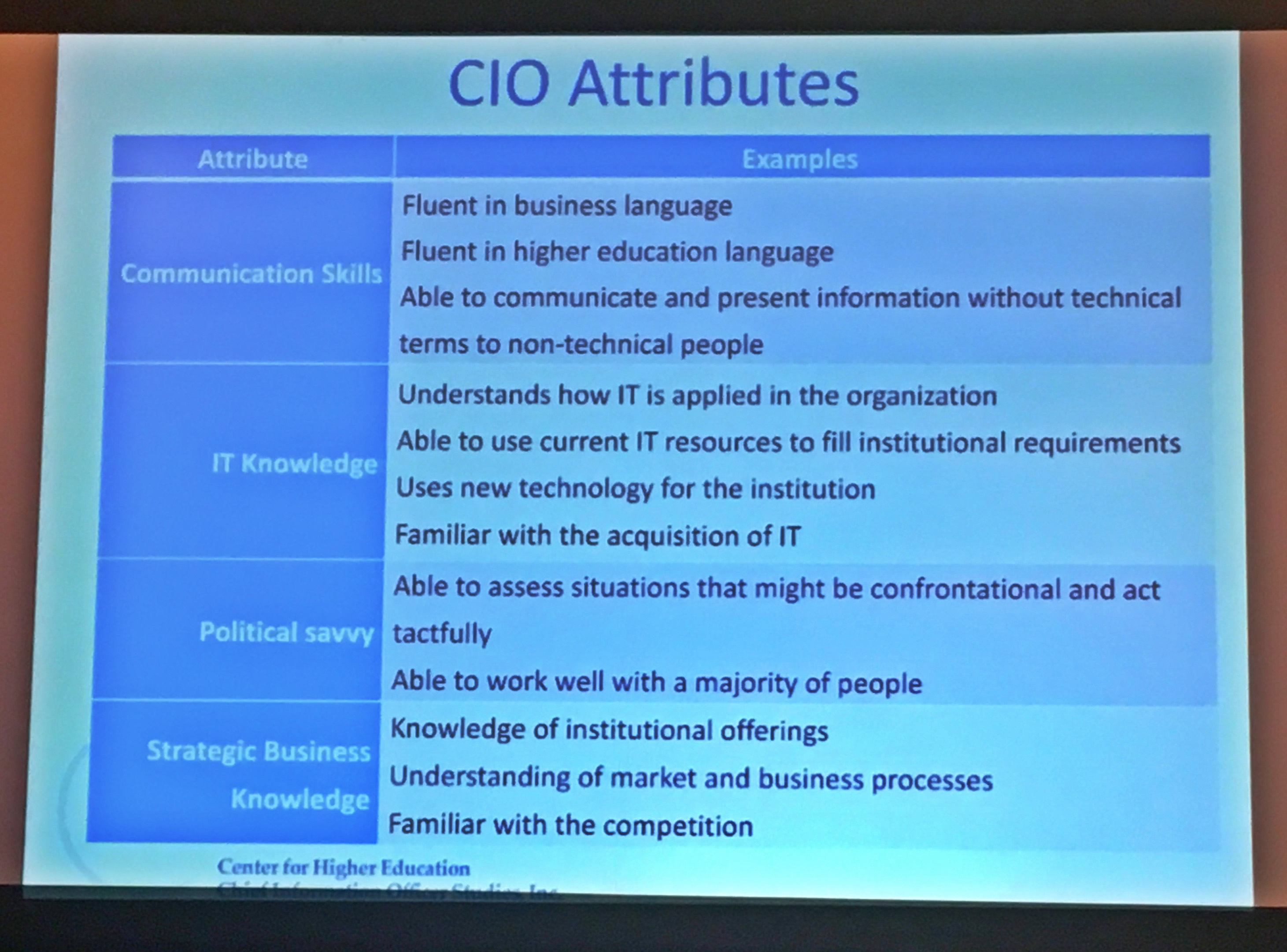“It used to be being a CIO meant making sure your IT staff down in the basement had enough Twinkies and Mountain Dew. But boy has that changed,” began Wayne Brown, VP or IT and CIO at Excelsior College in his session at the Campus Technology Conference in Boston on what it takes to be a CIO in 2016.
According to Brown, who also created the Center for Higher Education CIO Studies, Inc., (CHECS) while little has changed in terms of the gender and ethnicity of a CIO—white male over 51 years-old with an advanced degree who’s planning on retiring in 10 years—the role of the CIO has not only deepened, but campus technology leaders and CISOs (Chief Information Security Officers) are coming to expect more from a CIO’s qualifications for the position.
“I’ve been doing this presentation a few times now and I’m always happy to see people interested in becoming a CIO,” he said. “It’s a hard job but it’s a great job. There’s no other position outside of the President that can have this kind of impact at an institution.”
Brown’s CHECS conducts a yearly study, The Higher Education Chief Information Officer Roles and Effectiveness report, surveying thousands of technology leaders and CIOs around the world, but mostly in the US. The report contains a wide variety of information, including demographics of the CIO, their perception of their effectiveness, their opinion on the attributes and experiences necessary for a higher education CIO, and their plans for the future. The report also provides longitudinal data on a variety of questions to show trend data. The institution management teams (other VPs and Presidents) of those CIOs are then given a survey containing many of the same questions that the CIO answered. This two-step process provides CHECS with a way to compare CIO and IMT perceptions. The Higher Education Technology Leadership (TL) report contains information on those people most likely to succeed the higher education CIO in the future and includes the demographics of the TL, their career plans, activities they are undertaking to prepare for that future, and their perspective on the CIO job.
(Next page: 5 things to know about being a CIO in 2016)
According to the CHECS report, there are 5 key takeaways about the CIO of 2016:
1. They’re probably someone you know.
According to the report, 75 percent of CIOs in higher ed are from the higher ed sector, and most CIOs rise up through the ranks of the IT department. It’s also increasingly likely that the CIO is someone from within the institution.
2. They’re incredibly qualified.
82 percent of CIOs today have a Master’s degree (same percentage as 2003), and 81 percent of technology leaders surveyed said they believe a CIO should have a Master’s degree. However, while in every other yearly survey respondents said the choice of major doesn’t matter, this year the majority of respondents said a CIO’s major should be a technical major.
Yet, experience can trump a degree, said survey respondents. 75 percent said preparation for the CIO role should focus on serving a college-wide constituency. Other preparation should include being mentored by a CIO (63 percent), on-the-job training (62 percent), continuing education (19 percent), and certifications (18 percent).
3. They’re a role chameleon, but are appreciated for the classics.
Brown noted there are seven roles a CIO must undertake: business partner, classic IT support provider, contact oversight, informaticist and IT strategist, integrator, IT educator, and profession advocate.
Yet, when it comes to the role technology leaders say is most important, classic IT support (i.e. laptop setup and phone support) rules them all. CIOs themselves report spending 70 percent of their time on IT and institutional strategy. Their self-reported areas of responsibility are IT (69 percent), library (10 percent), research (8 percent) and facilities (4 percent).
4. They are communication masters.
Technology leaders and CIOs surveyed for the report said that leadership and communication skills are the two most important skills a CIO should have in 2016, followed by higher education knowledge, relationship building and technical knowledge.
Communication skills refer to the ability to be fluent in business language, fluent in higher education language, and able to communicate and present information without technical terms to non-technical people.
“I used to make horrible mistakes hiring people because I would hire based on their technical skills only,” noted Brown. “But you really have to have people who can hold a conversation and know how to dress properly for the role.”
5. They’re probably mentoring someone
Brown explained that training to be a CIO is much like a shoe-cobbler: you get to be skilled through on-the-job-training and years of experience. And much of this training comes from a mentor, usually the CIO at the time.
The report highlights that 47 percent of technology leaders said they were being mentored by their CIOs, while 59 percent of CIOs surveyed said they were currently mentoring someone.
However, 40 percent of those technology leaders who said they were being mentored by a CIO expressed that they were not doing any activities related to the mentorship. In other words, a mentor was there in name only.
“I can’t stress enough how important mentorship is for this position,” emphasized Brown. “Make sure that when you’re a mentor, you actually do something with that mentorship.”
For much more information on methodology and findings, click here.
- 25 education trends for 2018 - January 1, 2018
- IT #1: 6 essential technologies on the higher ed horizon - December 27, 2017
- #3: 3 big ways today’s college students are different from just a decade ago - December 27, 2017


